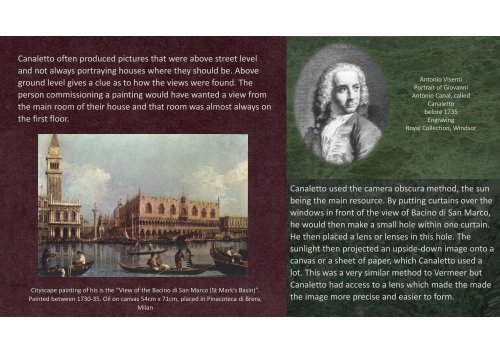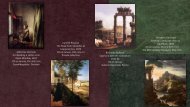Create successful ePaper yourself
Turn your PDF publications into a flip-book with our unique Google optimized e-Paper software.
Canaletto often produced pictures that were above street level<br />
and not always portraying houses where they should be. Above<br />
ground level gives a clue as to how the views were found. The<br />
person commissioning a painting would have wanted a view from<br />
the main room of their house and that room was almost always on<br />
the first floor.<br />
Antonio Visenti<br />
Portrait of Giovanni<br />
Antonio Canal, called<br />
Canaletto<br />
before 1735<br />
Engraving<br />
Royal Collection, Windsor<br />
Cityscape painting of his is the “View of the Bacino di San Marco (St Mark’s Basin)”.<br />
Painted between 1730‐35. Oil on canvas 54cm x 71cm, placed in Pinacoteca di Brera,<br />
Milan<br />
Canaletto used the camera obscura method, the sun<br />
being the main resource. By putting curtains over the<br />
windows in front of the view of Bacino di San Marco,<br />
he would then make a small hole within one curtain.<br />
He then placed a lens or lenses in this hole. The<br />
sunlight then projected an upside‐down image onto a<br />
canvas or a sheet of paper, which Canaletto used a<br />
lot. This was a very similar method to Vermeer but<br />
Canaletto had access to a lens which made the made<br />
the image more precise and easier to form.





